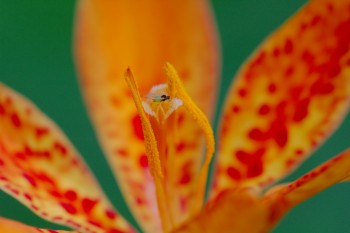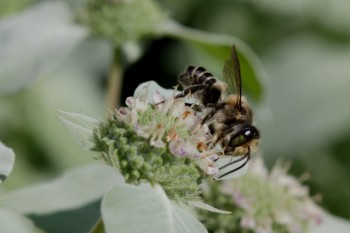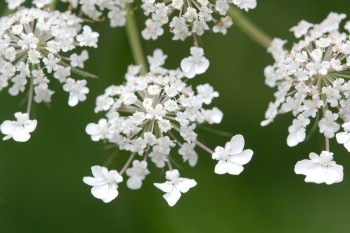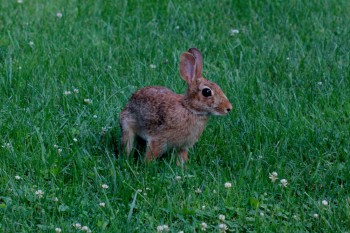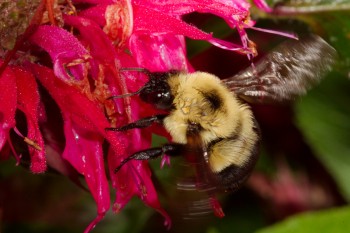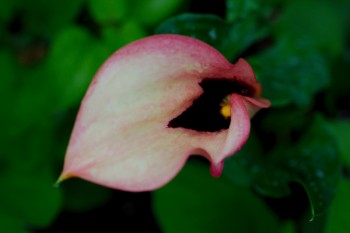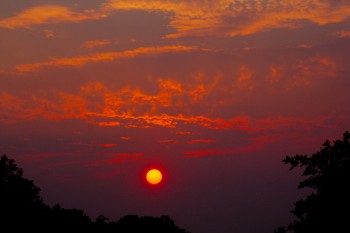The blackberry lily, formerly Belamcanda chinensis, but now Iris domestica, has started to bloom. I collected seeds for this many years ago and I’ve had it growing around the yard ever since (and our previous yard before that). I gather the seeds each fall and spread them liberally and I’m pretty much happy to have them come up wherever they can. This one has a very tiny aphid on the stigma.
Monthly Archives: July 2015
Iris domestica (Blackberry Lily) with Aphid
Megachile (Leaf-cutter Bee)
I haven’t taken the time to get a firm identification on this little bee, and the picture isn’t really good enough for a definitive ID in any case. I’m pretty sure, off the top of my head, that it is a leaf-cutter bee in the genus Megachile. The mountain mint (Pycnanthemum muticum) is at its peak (which lasts for a good long while, actually) and the bees are all over it, particularly when the sun is shining on it. That’s good for photographing them, of course, as the more light the easier it becomes, but it does mean I’m working in the bright, afternoon sun. Still, it’s one of my favorite things to do on a Saturday.
Calopteryx maculata (Ebony Jewelwing)
It’s high season for dragonflies and the pond next to my building is a good spot for finding them. Of course, taking pictures of them takes a little more than a camera and a good location. You also need a fair amount of patience. They tend to be shy and fly away when you get too close. Getting close is fairly important, though. I found a good spot, got reasonably comfortable, and waited. This female ebony jewelwing (Calopteryx maculata) landed nearby and then moved even closer. Close enough for a pretty near view.
Raspberries
I had a meeting over in the next building early this afternoon so I brought my camera and took a few pictures as I walked by the woods between buildings. There are raspberries ripe and starting to look quite good. I didn’t have time to pick many, but I took a picture of a few before pulling them off and munching on them as I finished my walk. Wild raspberries are one of the best things about the woods around here. Delicious.
Queen Anne’s Lace (Daucus carota)
We have a Queen Anne’s Lace (Daucus carota), otherwise known as wild carrot, growing at the corner of the garage. It isn’t doing any harm in terms of overrunning our garden, at least not so far, and we decided to let it stay at least as long as it’s in bloom. This is close-up of one small cluster of flowers in one of the large clusters that make up the flowering head of the plant.
The family to which Queen Anne’s Lace belongs (Apiaceae, the celery, carrot or parsley family) contains quite a few plants familiar to cooks for root vegetables (carrot, parsnip), stems and leaves (celery, parsley, coriander/cilantro) or seeds (anise, caraway, coriander, cumin, dill, fennel, etc.). The family also contains some dangerous plants, like the giant hogweed, the sap from which can cause severe burns through phytophotodermatitis, and hemlock, with its cocktail of poisonous alkaloids and of Socrates-killing fame.
Eastern Cottontail (Sylvilagus floridanus)
We have a huge number of rabbits in our neighborhood. I don’t think a day goes by that I don’t see at least one in our yard. There’s a very small one that we see in the back yard. When I pulled into the driveway this evening, fortunately with the windows open in my car, this little fellow (or filly) was munching on grass fairly close to the driveway. I was able to pull out the camera and get a few pictures before he got spooked and ran off.
Bumble Bee on Monarda
The bees are starting to get quite active now. They start when things start blooming, of course, and are never really far. But in the heat of July, when the flowers of summer are at their densest, they are easiest to find. The monarda (the aptly named bee balm) seems particularly attractive to bumble bees. The flowers are a bit past in terms of their looking all pretty for photography but the bees don’t seem to mind. I went out this evening and spent a while chasing bumble bees (Bombus impatiens) from flower to flower. This shot turned out reasonably well—the body if fairly sharp while the wings are blurred with motion.
Hope and Grace2
Our church has a longstanding tradition, going back at least a month, that on the first Sunday of each month we have a lunch together before our service, which is at 2:30 in the afternoon. It was such a beautiful day today and being the Fourth of July weekend, we thought a picnic would be appropriate. I took a few pictures and it wasn’t hard to pick this one as my favorite. The girls are Hope, Grace, and Charis (from the Greek χάρις, meaning grace). So, Hope, Grace, and Grace (or Grace2).
Calla Lily
Sometimes our days don’t go according to plan. Sometimes I think we should be more surprised when they do go according to plan. We expected to go to watch fireworks this evening. It’s a pretty simple plan and fairly common for July 4 in the good, old U.S. of A. Didn’t happen.
Without giving too much personal information (because anyone who needs to know the details already knows them), we spent the afternoon and evening in the ICU in Bethesda. Also, although we did not get word until tomorrow (in our time zone), so it wouldn’t have kept us home anyway, Cathy’s sister passed away late today. This calla lily is in honor and memory of her.
Dorothy and Karlee
I enjoyed photographing a wedding today so I actually have quite a few photographs that I could post. But I don’t really know the bride and groom, just the groom’s parents, so I decided I would pass on that and post this picture, taken later in the evening. Dorothy and Karlee went up to Frederick for the day today and then when I got home, we went out to IHOP for a late dinner. That’s where this picture was taken. So sad that we won’t have these two girls at the beach with us this year.
Sunset
An obvious difficulty when taking a photograph that includes the sun is that it’s fairly bright. I mean, that’s pretty obvious, I guess, but what do you do about it. It isn’t just bright, it is very, very bright. If you shorten the exposure so that the sun doesn’t overwhelm the photograph, then the rest of the sky becomes very dark.
One obvious thing to do is wait for a sunset when the sun is rendered darker due to atmospheric conditions. At times like that, the number of stops between the brightness of the sun and the sky is reduced to a more manageable amount. Even so, there is still a difference. I confess to cheating a little for this image. In the original the sun is nearly pure white, still having been overexposed a bit. But I took various exposures, including one that is three f/stops darker (1/3200 of a second instead of 1/400). The sun you see in this image came from the darker image, while the rest is from the lighter. It works, though, because that’s actually the way our eyes see the scene, having more dynamic range than camera sensors.
Two Fawns!
Generally I try not to post a picture of the same general subject two days in a row. If we’re travelling then I might, or if there is some multi-day event going on, but particularly in the when I’m just taking pictures in the back yard, I try not to. Well, for yesterday I posted a picture of a white-tail deer fawn. This evening there were two. How could I not go out and take pictures of them and post one of those? So, here are two white-tail deer fawns.

